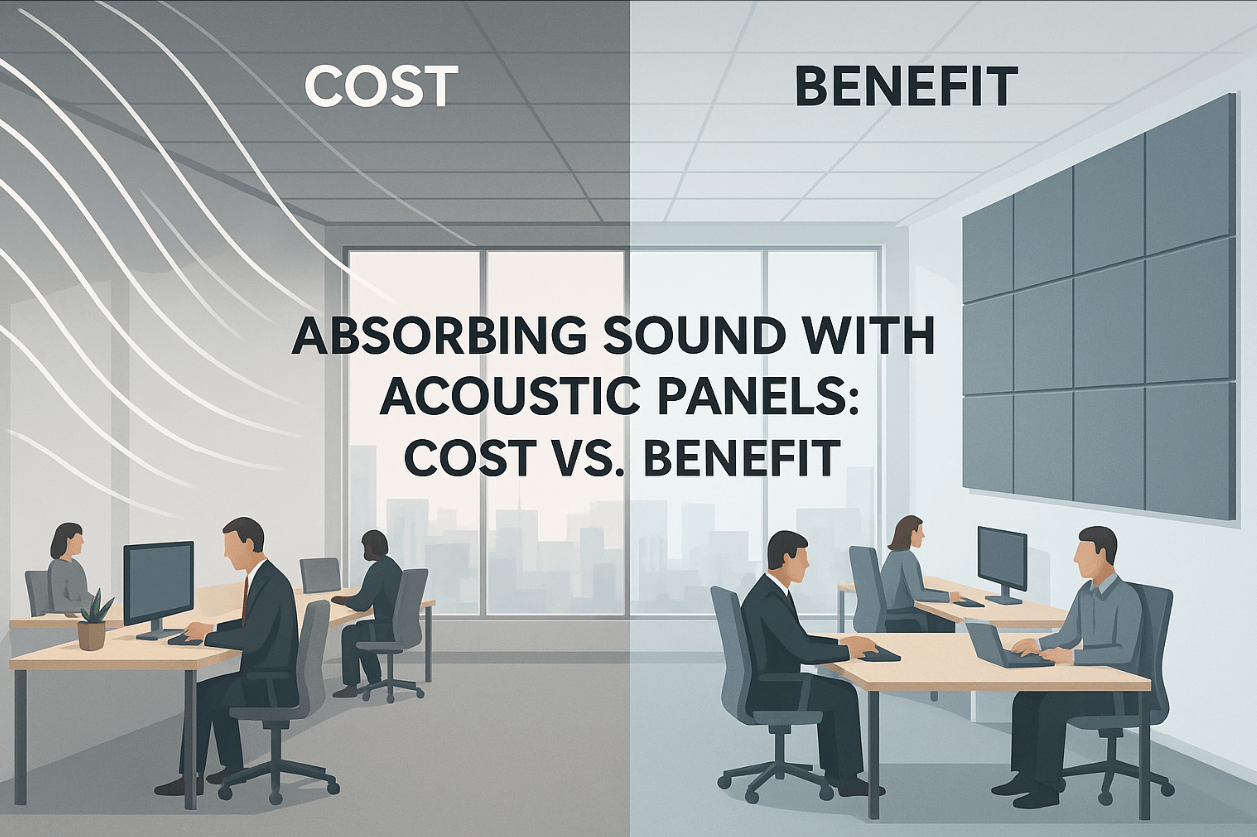Absorbing Sound with Acoustic Panels: Cost vs. Benefit
Open-plan offices, hotel lobbies, and busy classrooms share a hidden productivity killer: echo-laden chatter that pushes stress levels through the roof. Deciding whether the expense of absorbing sound with acoustic panels pays off means looking past sticker prices to the very real business gains of acoustic clarity. As a factory-direct wholesaler, Wellco Wholesale supplies bulk acoustic panels alongside garden, farm, and light-building materials—giving professional buyers a single source for cost-effective sound control. This guide dissects every yuan, decibel, and dividend so you can judge the true cost-versus-benefit equation.

The Science Behind Absorbing Sound with Acoustic Panels
How Acoustic Panels Work
Walls and ceilings act like mirrors for sound waves; panels turn those mirrors into sponges. Core fibers convert vibrational energy into heat, trimming reverberation time (RT60) and smoothing speech clarity. The effectiveness is rated by the Noise Reduction Coefficient (NRC)—0.00 reflects everything, 1.00 absorbs it all.
Key Materials and Ratings to Know
-
Mineral wool: High NRC (0.85-1.05), fire-resistant, mid-range price.
-
Fiberglass: Lightweight, NRC ~0.75-0.95, budget-friendly.
-
Recycled PET: Eco-certified, NRC ~0.75-0.90, low VOC.
Match thickness and density (3–6 lb/ft³ for offices, 6-8 lb/ft³ for studios) to your target RT60. Always confirm Class A fire rating when panels will flank emergency exits.
Cost Breakdown: Upfront and Hidden Expenses
Material & Sourcing Costs
| Specification | Retail Range (USD/ft²) | Pallet Price via Wellco Wholesale* |
|---|---|---|
| 1" PET (NRC 0.8) | $5.20–$8.10 | $3.60–$4.50 |
| 2" Mineral Wool (NRC 1.0) | $7.80–$11.00 | $5.40–$6.70 |
| *Pallet = ≥1,000 ft²; freight not included. Custom colors, cnc-cut logos, or antimicrobial coatings add 10-18 %. |
Installation, Maintenance, and Lifecycle
-
Labor: $3–$6 / ft² for adhesive mount, $5–$9 / ft² for Z-clip grids.
-
Maintenance: Vacuum quarterly; deep-clean fabric every 2-3 years ($0.15 / ft²).
-
Lifecycle: 10-15 years in offices; 7-10 years in dusty manufacturing zones.
Opportunity Cost of Doing Nothing
A University of Sydney review found that speech privacy complaints are the #1 driver of open-office dissatisfaction. If a 50-person sales floor loses just 5 % productivity to noise, at $55k average salary the annual hit is $137,500—dwarfing panel costs tenfold.
Benefits You Can Bank On
Productivity & Well-Being Data
-
Haworth research shows reducing reverberation from 1.2 s to 0.5 s boosts knowledge-worker task accuracy by 16 %.
-
The Finnish Institute of Occupational Health reported a 30 % drop in stress-related doctor visits after acoustic retrofits.
Compliance & Risk Mitigation
OSHA caps continuous industrial noise at 85 dB(A); exceeding it triggers mandatory hearing programs. Strategic acoustic treatment can cut exposures below thresholds, avoiding fines and worker-comp claims. LEED v4 awards up to 2 Indoor Environmental Quality points for specified NRC targets, nudging green-building scores across certification lines.
Brand Perception & Customer Experience
Restaurant surveys show that diners rate food 10 % tastier when background noise falls under 60 dB. Hotels with quiet corridors log higher RevPAR and five-star reviews. Sound comfort is marketing you can literally hear.
Case Study: Medium-Sized Manufacturing Office Retrofit
Baseline Noise Issues
A 6,000 ft² plant office averaged 78 dB(A) with metal roofs amplifying presses. HR logged two formal complaints per week.
Solution Implemented with Bulk Panels from Wellco Wholesale
-
1,200 ft² of 2" recycled-PET panels (NRC 0.9) ordered at pallet pricing.
-
Weekend adhesive install by a two-person crew; adhesive saved $1,800 in hardware.
Measured Outcomes
Post-install RT60 dropped from 1.4 s to 0.6 s. Productivity software showed an 18 % uptick in task completion speed within three months. Breakroom satisfaction surveys improved by 32 points.
Maximizing ROI When Buying Acoustic Panels
Selecting the Right Panel Specs
-
Define Target RT60:
-
Private office: 0.4-0.6 s
-
Open office: 0.6-0.8 s
-
Call center: 0.5-0.7 s
-
-
Calculate Required Sabins: Sabins = Volume × (NRC_target − NRC_existing) / 1.
-
Match Panel Area & Thickness to reach Sabins with minimal square footage.
Bulk Purchasing Tips & Supplier Checklist
-
Consolidate garden, building, and acoustic supplies to hit free-freight thresholds.
-
Verify ISO-9001 certificates and third-party fire tests.
-
Ask about Wellco Wholesale’s mixed-container loading to trim ocean freight.
DIY vs. Professional Installation
| Factor | DIY | Pro |
|---|---|---|
| Cost Control | High | Medium |
| Safety (ladders, lifts) | Moderate Risk | Low Risk |
| Warranty | Limited | Full |
| For projects under 300 ft² or ceiling height <10 ft, skilled facilities staff often succeed; larger multi-site rollouts favor certified installers who guarantee uniform NRC performance. |
Conclusion
Stack material, labor, maintenance, and the steep price of acoustic fatigue—and the scales tip decisively in favor of absorbing sound with acoustic panels for most commercial environments. Ready to turn decibels into dividends? Contact Wellco Wholesale for a fast, factory-direct quote and start hearing the payoff.
Frequently Asked Questions
Q1. How many panels do I need for a small conference room?
Measure length × width × height to get volume. Applying the rule of thumb (15-20 % wall coverage with NRC 0.8 panels) gives a reliable starting point; Wellco Wholesale can refine the count with reverberation calculators.
Q2. Can panels be custom-colored to match branding?
Yes. Most PET and fabric-wrapped lines offer Pantone matching with a 100 ft² minimum order and about 10 % cost premium.
Q3. Are acoustic panels safe in fire emergencies?
Look for ASTM E84 Class A or EN 13501-1 B-s1-d0 ratings. All panels sourced through Wellco Wholesale meet these standards, ensuring minimal flame spread and smoke.
Q4. How long before panels need replacing?
In climate-controlled offices, expect 10-15 years. High-humidity or particulate-heavy spaces may require replacement every 7-10 years.
Q5. Do panels block sound between rooms?
Absorptive panels mostly tame echoes inside a room. For inter-room isolation, combine them with mass-loaded barriers or staggered-stud walls.

